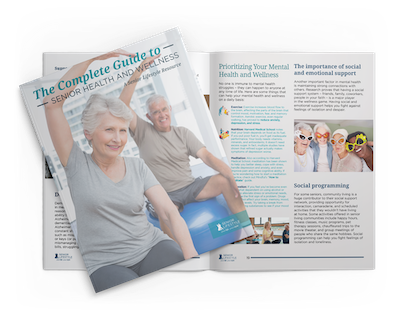Maintaining an active lifestyle becomes increasingly important for your physical health, mental well-being, and overall quality of life as you age. Engaging in outdoor activities not only provides exercise but also offers opportunities for social interaction, mental stimulation, and a connection with nature.
Among these activities, gardening stands out as a particularly rewarding and beneficial pursuit for seniors. In this article, we’ll explore the many benefits of gardening and other outdoor activities, along with some practical tips to help you get started.
The Therapeutic Power of Gardening
Gardening isn’t just a hobby; it’s a form of therapy that can work wonders for your physical, mental, and emotional well-being. Here are some of the multifaceted benefits that gardening offers:
Physical Health
Gardening provides you with a low-impact form of exercise that promotes cardiovascular health, muscle strength, and joint flexibility. Activities such as digging, planting, and watering engage various muscle groups, helping to maintain mobility and dexterity. Even simple tasks like reaching for tools or bending to tend to plants contribute to improved balance and coordination, reducing the risk of falls.
Additionally, spending time outdoors exposes you to natural sunlight, which is a vital source of vitamin D. Adequate vitamin D levels are essential for bone health and immune function, helping to prevent conditions like osteoporosis and infections.

Download The Complete Guide to Senior Health and Wellness
As people grow older, their health and wellness needs change. Read our eBook, "The Complete Guide to Health & Wellness for Seniors" for everything you need to know about staying healthy and happy as we age.
Download the GuideMental Stimulation
The act of gardening stimulates cognitive function and mental agility, keeping your mind sharp as you navigate tasks such as planning garden layouts, identifying plant species, and problem-solving when faced with pests or diseases. Engaging in these activities fosters creativity and critical thinking, providing a mental workout that can stave off cognitive decline and dementia.
Moreover, gardening offers a sense of rhythm and routine that can be particularly beneficial for seniors living with conditions like Alzheimer’s disease or dementia. The repetitive nature of tasks, combined with the sensory stimulation of working with soil and plants, can evoke memories and provide a comforting sense of familiarity.
Emotional Well-Being
Gardening has a profound impact on emotional health, offering a sense of purpose, accomplishment, and connection with nature. The nurturing aspect of gardening, from planting seeds to watching plants grow and flourish, instills a profound sense of responsibility and satisfaction. Seeing the tangible results of your efforts boosts self-esteem and confidence, fostering a positive outlook on life.
Furthermore, spending time outdoors surrounded by greenery and fresh air has been shown to reduce stress, anxiety, and symptoms of depression. The peaceful ambiance of a garden provides a sanctuary where you can escape from the pressures of daily life, allowing you to relax, unwind, and find solace in nature’s beauty.
Creating Accessible Gardens
Making gardens accessible involves thoughtful planning and design to ensure that gardening remains an enjoyable and comfortable activity for individuals with varying mobility levels. Here are some key considerations for creating accessible gardens:
Raised Garden Beds and Containers
Containers at waist height or gardens off the ground are essential components of accessible gardening. These elevated structures eliminate the need to bend or kneel, reducing strain on your joints and muscles.
Additionally, raised beds provide easier access if you use mobility aids, such as wheelchairs or walkers, allowing you to garden while seated or standing.
Pathways and Surfaces
Clear, level pathways are crucial for navigating the garden space safely and comfortably. Wide pathways accommodate mobility aids and provide ample space for maneuvering, turning, and reaching various garden areas.
Surfaces should be made of non-slip materials to prevent accidents, with smooth transitions between different sections of the garden to ensure seamless movement.
Accessible Tools and Equipment
Lightweight, ergonomic tools with padded handles are essential if you have limited strength or dexterity. Long-handled tools allow you to work from a comfortable standing position, minimizing the need for bending or stretching.
Additionally, tools with easy-grip handles accommodate arthritis or other hand-related conditions, making gardening tasks more manageable and enjoyable.
Sensory Considerations
Incorporating sensory elements into the garden enhances the overall experience. Planting fragrant flowers, herbs, or aromatic foliage stimulates the sense of smell, creating an immersive and sensory-rich environment.
Choosing plants with vibrant colors and interesting textures adds visual interest and appeal to the garden, encouraging you to engage with your surroundings.
Adaptive Gardening Techniques
These techniques cater to seniors with specific physical limitations or disabilities, allowing you to participate in gardening activities with ease.
For example, installing drip irrigation systems or soaker hoses reduces the need for manual watering, while lightweight, extendable reachers enable you to access plants and tools without straining yourself.
Seating and Rest Areas
Incorporating seating and rest areas within the garden provides you with opportunities to take breaks, relax, and enjoy your surroundings. Comfortable benches, chairs, or garden swings placed strategically throughout the garden offer convenient spots to rest, socialize with fellow gardeners, or simply admire the fruits of your labor.
Exploring Other Outdoor Activities
While gardening holds a special place among outdoor activities for seniors, there’s a wide array of alternative options that offer similar benefits of physical activity, mental stimulation, and connection with nature. Here are some additional outdoor activities worth exploring:
Walking and Hiking
Walking is a simple yet effective way to stay active and enjoy the outdoors. Whether it’s a leisurely stroll around the neighborhood, a walk in the local park, or a hike along nature trails, walking provides cardiovascular exercise, strengthens muscles, and improves overall fitness.
You can tailor the intensity and duration of your walks to suit your fitness levels and preferences, making it a versatile and accessible activity.
Birdwatching
Birdwatching offers delightful opportunities to connect with nature and observe the diverse avian species in your surroundings. Equipped with binoculars and field guides, you can explore nearby parks, nature reserves, or birdwatching hotspots to spot and identify birds of various shapes, sizes, and colors.
Mindfulness and attentiveness are encouraged by birdwatching, which also fosters a deeper appreciation for the natural world and its inhabitants.
Outdoor Painting and Sketching
If you have a creative flair, outdoor painting or sketching sessions provide a wonderful outlet for artistic expression and self-discovery. Setting up an easel or sketchbook in a scenic outdoor location allows you to capture the beauty of landscapes, gardens, and wildlife through their artistic interpretations.
Sketching or painting outdoors stimulate the senses and encourage you to notice intricate details and subtle nuances in your surroundings.
Photography Outings
Photography outings offer you the opportunity to explore the great outdoors while honing your photography skills and capturing memorable moments. Armed with a camera or smartphone, you can embark on photography expeditions to photograph landscapes, flora, fauna, and architectural landmarks.
Photography encourages creativity, curiosity, and a keen eye for composition, allowing you to document your outdoor adventures and share your unique perspectives with others.
Live a Healthy, Active Life at a Senior Lifestyle Community
By exploring gardening and other outdoor activities, seniors can stay active, engaged, and connected with the natural world, enhancing their physical health, mental well-being, and overall quality of life. Whether it’s watering a freshly planted garden, taking a leisurely stroll, observing birds in their habitat, or capturing moments through art and photography, there’s something for every senior to enjoy in the great outdoors.
Senior Lifestyle communities offer you freedom to pursue your pleasures – we’ll take care of your daily needs, such as cooking meals, cleaning, and maintaining your living area while you find comfort and enjoyment.
Find out more about Senior Lifestyle or schedule a visit today.

